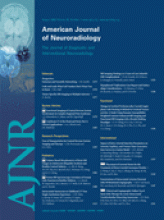The thalami are highly organized complexes of gray matter nuclei and white matter tracts, widely interconnected with the cerebral cortex and other gray matter structures, that play a central role in sensory relay and limbic and other important functional systems. Although the thalami predominantly contain gray matter nuclei, there are many myelinated and unmyelinated tracts in the thalami, many of them belonging to projection systems and intrathalamic circuits.1 The thalamic nuclear organization is compartmentalized by bands of white matter tracts (internal and external medullary laminae) traversing the thalami and separating different nuclear groups.1,2 The significant number of axonal tracts combined with the described laminated and compartmentalized cytoarchitectural organization of the thalami are likely responsible for the observed anisotropy in diffusion tensor imaging studies.3,4
Because of the central role of the thalami in many physiologic systems, it is not surprising to find an increasing number of studies using a variety of different MR imaging modalities (conventional volumetric assessment, magnetization transfer, MR spectroscopy, and diffusion tensor imaging) that demonstrate the central role of thalamic involvement in the pathophysiology of various pathologic conditions (including multiple sclerosis, schizophrenia, and head trauma, to name a few).5–7 In particular, thalamic involvement is becoming increasingly recognized as a significant step in the development of clinical disability and memory impairment in multiple sclerosis.8 Tovar-Moll et al9 in an article published in the current issue of the American Journal of Neuroradiology demonstrate thalamic abnormalities in diffusion tensor metrics that correlate with clinical disability scores, in keeping with similar studies published on the subject.10,11 Most interesting, Tovar-Moll et al reported increased fractional anisotropy (FA) and mean diffusivity (MD) values in the thalamus in comparison with matched controls. The significance of these tensor measurements is clearly a matter for further research to elucidate whether the increased FA values are attributable to neural plasticity changes,11 whereas the increased MD values reflect the presence of demyelination and neuronal damage (direct or indirect due to wallerian degeneration).
Overall, the article by Tovar-Moll et al9 highlights the potential of diffusion tensor imaging techniques in the evaluation of gray matter pathology, particularly of the thalamus, and contributes to our understanding of the pathophysiology of multiple sclerosis.
- American Society of Neuroradiology











